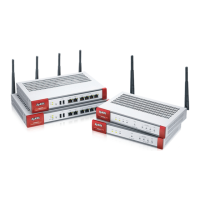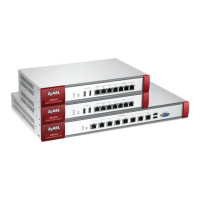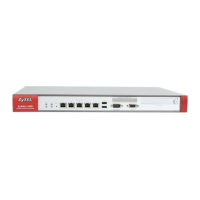Chapter 35 BWM (Bandwidth Management)
ZyWALL USG Series User’s Guide
684
Inbound kbps Type how much inbound bandwidth, in kilobits per second, this policy allows the traffic to
use. Inbound refers to the traffic the Zyxel Device sends to a connection’s initiator.
If you enter 0 here, this policy does not apply bandwidth management for the matching
traffic that the Zyxel Device sends to the initiator. Traffic with bandwidth management
disabled (inbound and outbound are both set to 0) is automatically treated as the lowest
priority (7).
If the sum of the bandwidths for routes using the same next hop is higher than the actual
transmission speed, lower priority traffic may not be sent if higher priority traffic uses all of
the actual bandwidth.
Outbound kbps Type how much outbound bandwidth, in kilobits per second, this policy allows the traffic to
use. Outbound refers to the traffic the Zyxel Device sends out from a connection’s initiator.
If you enter 0 here, this policy does not apply bandwidth management for the matching
traffic that the Zyxel Device sends out from the initiator. Traffic with bandwidth
management disabled (inbound and outbound are both set to 0) is automatically treated
as the lowest priority (7).
If the sum of the bandwidths for routes using the same next hop is higher than the actual
transmission speed, lower priority traffic may not be sent if higher priority traffic uses all of
the actual bandwidth.
Priority This field displays when the inbound or outbound bandwidth management is not set to 0.
Enter a number between 1 and 7 to set the priority for traffic that matches this policy. The
smaller the number, the higher the priority.
Traffic with a higher priority is given bandwidth before traffic with a lower priority.
The Zyxel Device uses a fairness-based (round-robin) scheduler to divide bandwidth
between traffic flows with the same priority.
The number in this field is ignored if the incoming and outgoing limits are both set to 0. In
this case the traffic is automatically treated as being set to the lowest priority (7) regardless
of this field’s configuration.
Maximize
Bandwidth Usage
This field displays when the inbound or outbound bandwidth management is not set to 0
and the BWM Type is set to Shared. Enable maximize bandwidth usage to let the traffic
matching this policy “borrow” all unused bandwidth on the out-going interface.
After each application or type of traffic gets its configured bandwidth rate, the Zyxel
Device uses the fairness-based scheduler to divide any unused bandwidth on the out-
going interface among applications and traffic types that need more bandwidth and
have maximize bandwidth usage enabled.
Maximum If you did not enable Maximize Bandwidth Usage, then type the maximum unused
bandwidth that traffic matching this policy is allowed to “borrow” on the out-going
interface (in Kbps), here.
802.1P Marking Use 802.1P to prioritize outgoing traffic from a VLAN interface.
Priority Code This is a 3-bit field within a 802.1Q VLAN tag that’s used to prioritize associated outgoing
VLAN traffic. "0" is the lowest priority level and "7" is the highest. See Table 244 on page 681.
The setting configured here overwrites existing priority settings.
Interface Choose a VLAN interface to which to apply the priority level for matching frames.
Related Setting
Log Select whether to have the Zyxel Device generate a log (log), log and alert (log alert) or
neither (no) when any traffic matches this policy.
OK Click OK to save your changes back to the Zyxel Device.
Cancel Click Cancel to exit this screen without saving your changes.
Table 245 Configuration > Bandwidth Management > Add/Edit
LABEL DESCRIPTION

